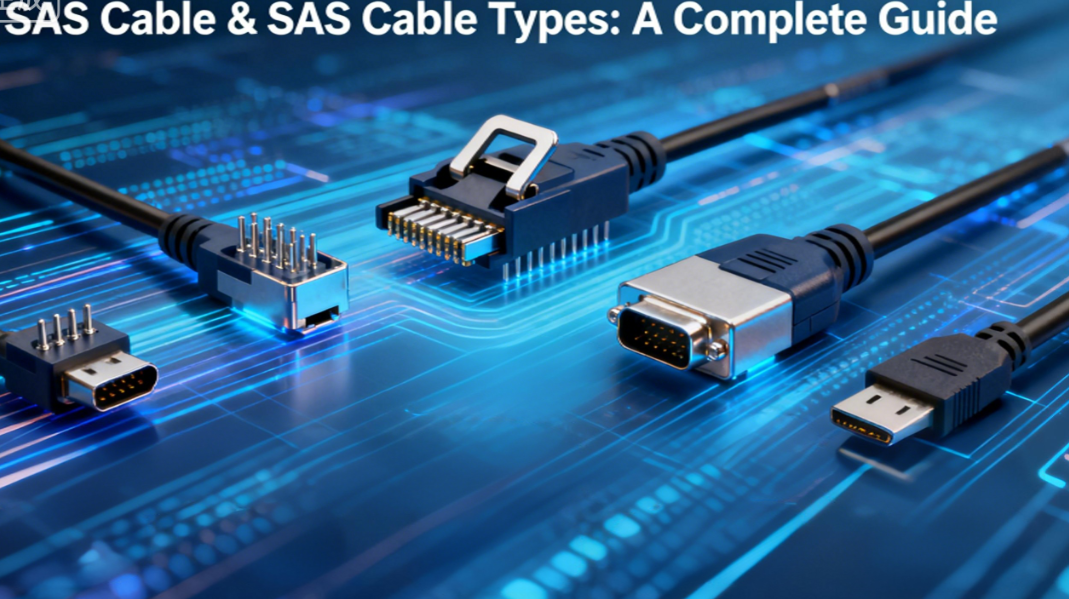Understanding SAS Cables: A Comprehensive Guide to Types, Selection, and Applications
In enterprise-level storage, server clusters, and data center hardware architectures, SAS cables (Serial Attached SCSI cables) serve as core components ensuring high-speed, stable data transmission. Diverse requirements for transmission rates, interface compatibility, and connection methods across different scenarios have driven the development of multiple SAS cable types.

What Is SAS Cable? The “Enterprise-Grade Benchmark” for Data Transmission
SAS (Serial Attached SCSI) is a serial transmission protocol evolved from traditional parallel SCSI technology. As the physical medium for this protocol, SAS Cable facilitates data exchange between servers and storage devices (such as hard disk arrays, SSDs, tape drives) as well as between devices and backplanes.
Unlike standard consumer cables, SAS Cable possesses three core characteristics:
· Transmission Stability: Supports full-duplex serial transmission with strong interference resistance and significantly lower error rates than standard cables;
· Speed Compatibility: Scales from early 3Gbps to next-generation 22.5Gbps, adapting to different generations of SAS devices;
· Cross-Protocol Compatibility: Certain SAS Cable Types offer backward compatibility with SATA devices, reducing hardware upgrade costs.
Whether powering massive storage clusters in data centers or expanding local disk capacity in servers, SAS cables serve as the “invisible foundation” ensuring business continuity.
Key SAS Cable Types: Selecting the Right Type to Avoid Pitfalls
Based on differences in interface specifications, transmission rates, and connection methods, SAS Cable Types fall into three core categories. Each type emphasizes distinct application scenarios and performance characteristics, forming the core basis for selection.
Classification by Interface Type: The Physical Bridge to Devices
Interfaces serve as the critical connection point between SAS cables and devices. Compatibility is directly determined by the interface type matched to the SAS Cable Type. Common types include:
SFF-8482 Interface SAS Cable: The classic interface for SAS 1.0/2.0 generation devices (3Gbps/6Gbps transfer rates). Commonly found in traditional servers and entry-level storage arrays, its 29-pin design ensures robust stability, making it the mainstream choice for early enterprise-grade equipment.
SFF-8643 SAS Cable: An upgraded high-density interface supporting SAS 3.0/4.0 protocols (12Gbps/22.5Gbps). Its more compact pin layout suits space-constrained rack servers and high-density storage backplanes, making it the preferred interface type for mid-to-high-end data centers today;
SFF-8087/SFF-8088 SAS Cable: A multi-channel interface commonly used for parallel connections of multiple devices (e.g., servers connecting to multiple hard drives simultaneously). It supports 4-channel transmission with speeds up to 6Gbps per channel (SAS 2.0), making it suitable for scenarios requiring expanded storage ports.
Classification by Transmission Speed: The “Speed Ladder” for Performance Matching
Transfer rate is the core differentiator among SAS Cable Types. Rate tiers are tightly bound to SAS protocol versions, requiring selection based on device compatibility:
SAS 1.0 Cable (3Gbps): An early type operating at 3Gbps, suitable for legacy servers and low-speed storage devices. Currently used primarily for maintaining existing equipment, rarely chosen for new deployments.
SAS 2.0 Cable (6Gbps): Cost-effective choice compatible with SAS 1.0 devices. Widely used in SMB servers and surveillance storage arrays, balancing performance and cost.
SAS 3.0 Cable (12Gbps): Current mainstream type supporting high-speed storage like SSDs. Meets high-bandwidth demands for big data processing and cloud computing, serving as the core choice for new data center deployments.
SAS 4.0 Cable (22.5Gbps): Next-generation high-speed type, suited for extreme performance scenarios like AI training and supercomputing clusters. Supports longer transmission distances (some passive cables reach 10 meters), representing the future direction for technology upgrades.
Classification by Connection Method: Architecture-Adaptive “Layout Solutions”
Based on device connectivity requirements, SAS Cable Types can further be categorized as:
Direct-Attach SAS Cable: Directly connects two devices (e.g., server-to-SAS drive, server-to-storage array) without branching, minimizing transmission loss. Ideal for short-distance point-to-point connections (typical lengths: 0.5-3 meters);
Branched SAS Cable: Features one main interface and multiple sub-interfaces (e.g., 1-to-4, 1-to-8) at the other end. Ideal for connecting multiple storage devices to a single server, reducing cable redundancy and simplifying cabling.
Stacking SAS Cable: Used for cascading storage devices (e.g., stacking array cabinets), enabling cross-device data synchronization and enhancing storage cluster scalability.
Core Advantages of SAS Cable: Why It's the Preferred Choice for Enterprise-Level Scenarios
Compared to alternatives like SATA cables or standard Ethernet cables, SAS Cable and its diverse SAS Cable Types meet the stringent demands of enterprise-level scenarios. Its core advantages include:
Enhanced Reliability: Utilizes shielded twisted pair (STP) or multimode fiber materials, offering outstanding resistance to electromagnetic interference (EMI) and crosstalk, making it suitable for complex electromagnetic environments in data centers;
Extended Transmission Distance: Passive copper SAS cables support up to 10 meters (SAS 4.0), while active cables extend beyond 30 meters—far surpassing SATA cables' 1-meter limitation for efficient long-distance data center cabling;
Simplified Management: Certain SAS Cable Types support hot-swapping, enabling device replacement or expansion without system downtime, minimizing business interruption risks;
Extended Lifecycle: Designed to enterprise-grade standards, these cables withstand frequent plugging/unplugging and resist aging, offering a service life of 5-8 years to reduce long-term maintenance costs.
SAS Cable Selection Tips: Avoid Pitfalls, Achieve Precise Matching
The core of selection lies in “defining requirements + matching SAS Cable Types.” Follow these 4 key steps to avoid common pitfalls:
Verify Device Interfaces: Prioritize checking interface specifications on servers and storage devices (e.g., SFF-8643, SFF-8482) to ensure full interface compatibility and prevent unusability due to mismatched ports;
Determine Transfer Rate: Select the appropriate speed tier based on operational needs—6Gbps (SAS 2.0) for standard office storage, 12Gbps (SAS 3.0) for big data/cloud computing, and 22.5Gbps (SAS 4.0) for future upgrade readiness;
Plan Connection Methods: Use direct-attach cables for point-to-point connections, branch cables for multi-device expansion, and stacking cables for device cascading. Pay attention to cable length (recommend allowing 0.5 meters of slack to prevent strain).
Prioritize Quality Brands: Avoid transmission instability caused by substandard cables. Select brand-name products compliant with SFF specifications to ensure shielding and connector craftsmanship meet standards, thereby extending service life.
Choosing the Right SAS Cable Types Fortifies the Foundation of Data Transmission
In this data-driven era, the transmission performance of enterprise-grade storage and servers directly impacts business efficiency. As a core connectivity component, the key to selecting the right SAS Cable lies in a deep understanding of SAS Cable Types. Whether considering interfaces, data rates, or connection methods, only precise alignment with specific application requirements can fully leverage the advantages of the SAS protocol, achieving “high-speed, stable, and reliable” data transmission.
Looking ahead, as the SAS 4.0 protocol gains widespread adoption, SAS Cable Types supporting 22.5Gbps speeds will become the mainstream choice for data center upgrades. Features like compatibility, long-distance transmission, and low power consumption will also shape the future direction of cable technology. Mastering the core knowledge of SAS cables will provide crucial support for optimizing enterprise hardware architectures and controlling costs.



